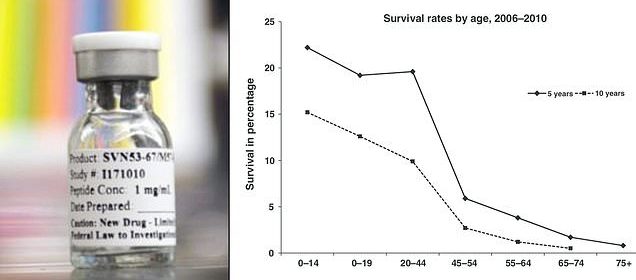Vaccine for deadly brain cancer found to nearly DOUBLE survival rate

Vaccine to treat deadliest brain cancer found to DOUBLE average survival rate that is only 15 months nearly
- The shot, called SurVaxM, targets a protein found in the tumors called survivin
- The experimental vaccine extended the survival time to 26 months in early trials
- READ MORE: First ever woman to receive breast cancer vaccine in remission
A vaccine to slow the progression of the deadliest form of brain cancer has shown promise in early clinical trials by extending the average survival rate from 15 to 26 months.
The shot, called SurVaxM, targets a protein found in tumors called survivin. It is thought that if the protein is destroyed, the cancer cells will die.
Scientists are hopeful the vaccine could save those suffering from glioblastoma, one of the most fatal and treatment-resistant cancers, which can result in death in six months or less if left untreated.
The vaccine is among hundreds of experimental cancer shots and medicines in early trials.
In an early clinical trial, SurVaxM extended the survival time for people with glioblastoma to an average of 26 months
The survival rate of glioblastoma by age. It is one of the deadliest cancers and the deadliest form of brain cancer
Glioblastoma makes up nearly half of all malignant brain tumors and has a five-year survival rate of 6.8 percent.
More than 14,000 people in the US were diagnosed last year, according to the National Tumor Brain Society.
SurVaxM works by targeting a protein found in tumors called survivin. It is thought that if the protein is destroyed, the cancer cells will die.
John Wishman, 61, of Buffalo, New York, was diagnosed with glioblastoma in the fall of 2020, NBC News reported.
Three years later, he is doing well, despite the cancer’s average survival rate being just 12 to 18 months.
Mr Wishman got the experimental vaccine through an expanded access program, enabling seriously ill patients to try experimental treatments.
World’s first cancer vaccine one step closer to reality
A cancer vaccine made by Moderna has been given ‘breakthrough therapy’ status by health chiefs, paving the way for a fast-tracked approval.
His daughter Lydia is a nurse at Roswell Park Comprehensive Cancer Center, where researchers are studying the medicine.
In an early clinical trial, SurVaxM extended the survival time for people with glioblastoma to an average of 26 months.
Made by New York-based MimiVax, the drug will be tested in a larger trial of 270 patients, hoping to confirm the results.
Participants will be from more than 10 US and China sites and compare the shot to standard cancer care.
Retired lawyer Tracey Kassman, 65, was enrolled in the same trial as Mr Wishman in April 2022, three months after being diagnosed with glioblastoma.
She now has a dose every two months, but because the trial is randomized and double-blind, she does not know whether she is getting the vaccine or a placebo.
Participants also have an MRI brain scan every two months to monitor potential progression.
Glioblastomas are very aggressive forms of cancer — they grow rapidly and often take over other parts of the brain and spinal cord before someone is even diagnosed.
Dr Honggang Cui, an associate professor of chemical and biomolecular engineering at Johns Hopkins Whiting School of Engineering, described glioblastoma tumors as ‘like octopus tentacles reaching into other parts of the brain’.
Usual treatment for the cancer involves chemotherapy, radiation and surgery.
However, the tumor will often grow back if any cancer cells are left.
SurVaxM trains the immune system to target and attack the cancer cells, meaning if they do come back, the body automatically kills them off and stops a new tumor from forming.
Dr Cui said the treatment is ‘promising’ and ‘could bring hope to people who are impacted by glioblastoma’.
Trial participants will have surgery beforehand to remove as much of the tumor as possible.
Radiation and chemotherapy will follow, alongside a drug called temozolomide.
The vaccine is given in the arm just like a flu injection, as four doses spread over two months, followed by a booster dose every two months.
Source: Read Full Article


